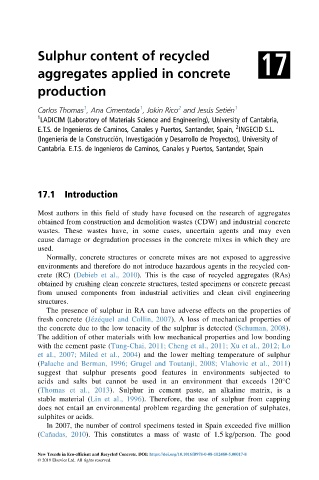Page 551 - New Trends in Eco efficient and Recycled Concrete
P. 551
Sulphur content of recycled 17
aggregates applied in concrete
production
1
2
1
Carlos Thomas , Ana Cimentada , Jokin Rico and Jesu ´s Setie ´n 1
1
LADICIM (Laboratory of Materials Science and Engineering), University of Cantabria,
2
E.T.S. de Ingenieros de Caminos, Canales y Puertos, Santander, Spain, INGECID S.L.
(Ingenierı ´a de la Construccio ´n, Investigacio ´n y Desarrollo de Proyectos), University of
Cantabria. E.T.S. de Ingenieros de Caminos, Canales y Puertos, Santander, Spain
17.1 Introduction
Most authors in this field of study have focused on the research of aggregates
obtained from construction and demolition wastes (CDW) and industrial concrete
wastes. These wastes have, in some cases, uncertain agents and may even
cause damage or degradation processes in the concrete mixes in which they are
used.
Normally, concrete structures or concrete mixes are not exposed to aggressive
environments and therefore do not introduce hazardous agents in the recycled con-
crete (RC) (Debieb et al., 2010). This is the case of recycled aggregates (RAs)
obtained by crushing clean concrete structures, tested specimens or concrete precast
from unused components from industrial activities and clean civil engineering
structures.
The presence of sulphur in RA can have adverse effects on the properties of
fresh concrete (Je ´ze ´quel and Collin, 2007). A loss of mechanical properties of
the concrete due to the low tenacity of the sulphur is detected (Schuman, 2008).
The addition of other materials with low mechanical properties and low bonding
with the cement paste (Tung-Chai, 2011; Cheng et al., 2011; Xu et al., 2012; Lo
et al., 2007; Miled et al., 2004) and the lower melting temperature of sulphur
(Palache and Berman, 1996; Grugel and Toutanji, 2008; Vlahovic et al., 2011)
suggest that sulphur presents good features in environments subjected to
acids and salts but cannot be used in an environment that exceeds 120 C
(Thomas et al., 2013). Sulphur in cement paste, an alkaline matrix, is a
stable material (Lin et al., 1996). Therefore, the use of sulphur from capping
does not entail an environmental problem regarding the generation of sulphates,
sulphites or acids.
In 2007, the number of control specimens tested in Spain exceeded five million
(Can ˜adas, 2010). This constitutes a mass of waste of 1.5 kg/person. The good
New Trends in Eco-efficient and Recycled Concrete. DOI: https://doi.org/10.1016/B978-0-08-102480-5.00017-8
© 2019 Elsevier Ltd. All rights reserved.

